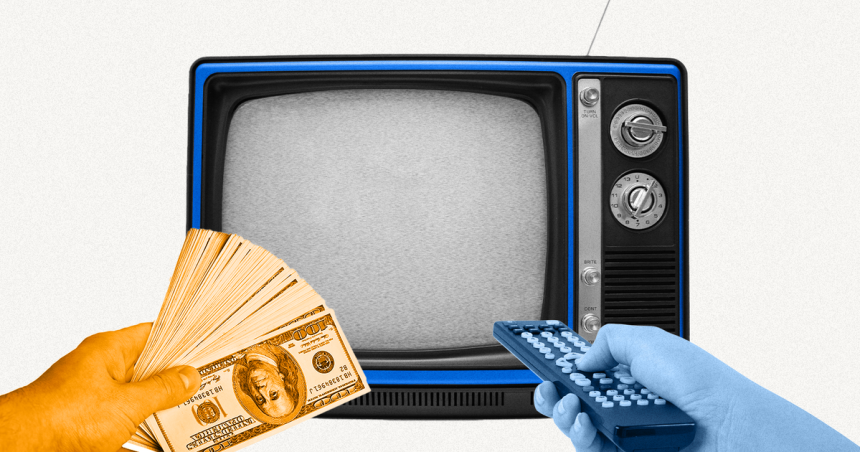Looking into upping streaming spend this year? So is basically everyone else.
As media companies continue to invest in building out ad capabilities across both free and subscription streaming services, marketing investment in the channel continues to climb. In June, ad spend across CTV platforms and streamers like Disney+ and Roku reached a landmark $1 billion, according to the ad intelligence tracking company Vivvix, and more than half of advertisers said they plan to spend more on connected TV in 2023, according to research conducted earlier this summer by Advertiser Perceptions.
“This year, we’ve had a lot more clients interested in testing it,” Adrienne Rice, media director at performance agency M&C Saatchi Performance, told Marketing Brew. “It’s definitely growing in popularity and interest.”
While interest seems high, the landscape is always changing—so what’s the DL with connected TV and streaming in 2023? Marketing Brew chatted with a few media buyers about what to know about the channel in 2023 and how to best take advantage of it. Here’s what you should know.
Use cases are changing
Kasha Cacy, chief media officer at marketing agency Known, said clients looking to lean further into CTV and streaming have a lot to consider when determining how best to approach the channel.
“If you’re launching a brand, or trying to build a brand’s awareness or pivot a brand, you may want to be in those more premium placements,” Cacy said, noting that for some advertisers, that may include premium streaming as well as linear TV options like live sports.
Still, the platform’s use cases are expanding, especially as connected TV platforms build out capabilities and scale up and as more demand-side platforms jump into the streaming waters. Many platforms offer more precise targeting and outcomes measurement, and some, including Peacock and Roku, offer shoppable ads, allowing brands to track purchases directly.
“Our focus when buying CTV is really driving those results and looking at people that were exposed to the ad: Did they download the app? Did they subscribe? Did they come back, or are they using the app after seeing that CTV ad?” Rice said. “It’s becoming more of a performance channel, whereas previously it was seen as a top-of-funnel, brand awareness play.”
The channel is getting more cost-competitive
As the use cases expand, costs are going down—sort of. CTV inventory “has always been on the pricier side,” especially compared to digital channels like display advertising, Rice told us, but she’s noticed that CPMs have decreased this year, making it a more affordable option for many advertisers.
Get marketing news you’ll actually want to read
The email newsletter guaranteed to bring you the latest stories shaping the marketing and advertising world, like only the Brew can.
“Before, it was more like $30–$50 CPMs, and now we’re definitely seeing pockets where it’s getting more to the $15 CPM,” she said. “As more and more programmatic or performance DSPs get into the CTV space, we’re seeing more efficiencies and more pockets of cheaper inventory.”
That’s working in favor of some clients looking into CTV, who may want to take advantage of that lower-cost inventory to help boost reach and frequency, Cacy said; fast food, retail, and CPG clients could find that application particularly attractive.
At some premium streaming publishers, though, prices remain higher and there can be fewer opportunities to optimize, Rice told us. With that said, she is optimistic that as user bases increase, there will be more options for marketers down the line.
“As more of these premium streaming companies offer more ad-supported tiers, and they are increasing their user base on the AVOD services, then we are probably going to see a lot more opportunity to work with them directly,” Rice said.
It’s only getting more complicated
In general, advertisers are optimistic about performance on connected TV. In interviews with Advertiser Perceptions, marketers reported that they believe return on investment in the channel is increasing, Nicole Perrin, Advertiser Perception’s SVP of business intelligence, told Marketing Brew.
That optimism is tempered by existing pain points, including continued measurement concerns, Rice and Cacy said. Beyond that, growth in the space can present buying challenges, since each platform is different.
“You can target in some ways on some platforms, you can target in different ways on other platforms,” Cacy said. “It’s much less consistent, so it can be a lot more manual labor to get a buy priced and sorted and executed.” It can also be a challenge to know where ads run—especially if they are bought programmatically, Cacy said.
There are improvements every day, buyers said, but the ongoing shift to streaming means those challenges are here to stay, especially as linear viewership continues to decline.
“The scale isn’t there in either place right now,” Cacy said. “If you have more targeted audiences, it’s certainly possible to reach them potentially solely [on] streaming…But if you’re a mass brand, you’ll probably need to use both [channels]. I think that’s where we’re going to be for the foreseeable future.”
Read the full article here










